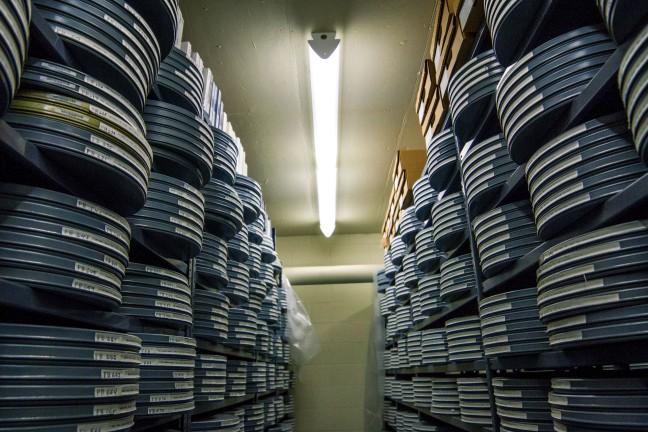“The treasure which you think not worth taking trouble and pains to find, this one alone is the real treasure you are longing for all your life.”
These are the words author B. Traven used to introduce his 1927 novel “The Treasure of the Sierra Madre,” made famous by John Huston’s 1948 film of the same name.
There is a place where you can find the book’s first edition, the various drafts of its screen adaptation and even the transcript of its promotional trailer, all tucked neatly side by side in a folder that’s hand delivered to you.
It’s not in the vaults of Warner Bros. Studios. It’s not even within the jurisdiction of Hollywood.
The folder is in Madison, in the Wisconsin Center for Film and Theater Research.
“I think it’s a really special part of Madison,” the center’s head archivist Amy Sloper said. “We’re preserving very important parts of film culture for the world.”
Housed within the Wisconsin Historical Society, the WCFTR is a treasure trove of film history that’s working behind the scenes to keep film culture alive and available to the public, both in Madison and around the world.

Erik Brown/The Badger Herald
While its existence may come as a surprise to many, the WCFTR has been on campus for over five decades and has a rich history of its own. By the end of the 1950’s, the Historical Society – a separate entity from the university – had acquired an extensive collection of mass media materials.
Feeling the archives could be expanded to areas of media other than mass communication, University of Wisconsin’s Speech and Theater department (now known as Communication Arts) formed the WCFTR in 1960, deciding the center would be owned by and funded through the university, but share space with the Historical Society as an archive devoted solely to the performing arts.
Over the course of its 55 years, the WCFTR has risen to prominence as one of the world’s largest archives of research materials relating to the entertainment industry, and patrons travel from far and wide to browse its collections. But with Wisconsin being so far from the bright lights and red carpets of Hollywood, the center’s success is likely to raise some eyebrows.
It’s a reaction Vance Kepley, the WCFTR’s director, gets often.
“To this day, there are major archives on either coast that are actually bigger than ours, but they kind of formulated themselves later,” Kepley said, laughing. “We just took the initiative.”
At the time of the center’s formation in 1960, the idea of film as an art form worthy of critical analysis was just beginning. As a result, most archives hadn’t considered opening their vaults to the medium.
The WCFTR capitalized on this, marking the beginning of what is now considered “The Golden Age of Collecting” for the center.
Because of this initiative, the following decades saw the acquisition of both the United Artists and Kirk Douglas papers, which to this day remain the WCFTR’s most significant collections. These two collections not only expanded the areas of research the WCFTR could offer, but also gave it the footing needed in the archiving world to further its collections despite its disadvantageous location.
Today, the WCFTR possesses collections from more than 300 notable playwrights, television and motion picture writers, producers, actors, designers, directors and production companies. Its film collection contains prints of virtually every feature title released by Warner Bros., RKO and Monogram Pictures between 1931 and 1949.
And that’s not even counting the promotional materials, photographs, corporate documents, written correspondences and scripts housed within the WCFTR’s vaults.
But what really makes the WCFTR unique is its willingness to share the collection with the public. In the digital era, physical film is becoming increasingly rare and many archives are reluctant to risk lending out their materials to inexperienced hands.

Erik Brown/The Badger Herald
“Here, the collection’s open to anybody,” Sloper said. “We’re very liberal about who we loan to because we’d like to keep the exhibition alive.”
Although the center requires proof of research from anyone wanting to view film prints, the multitude of promotional materials, scripts and legal papers in the Historical Society’s fourth floor reading room are up for grabs. Make a request, and a staff member will disappear momentarily into one of two locked vaults and return with a box full of history.
But the WCFTR’s outreach extends to the UW community as well. Because the center is a member of the International Federation of Film Archives, it has the ability to borrow film prints from other federation-approved institutions. The WCFTR often uses this privilege to contribute to the programming for the Cinematheque, a university organization devoted to showcasing rare cinema.
“Our partnership [with WCTFTR] allows us to borrow from archives around the world that we probably wouldn’t be able to get otherwise,” Cinematheque director of programming Jim Healy said.
At the moment, the WCFTR is not accepting any new collections. The archive holdings have outgrown the original storage space available in the Historical Society, and the two organizations are moving forward on plans to build a new storage facility on state land in east Madison. Construction is expected to be completed in 2018.
Until then, the treasures of the Wisconsin Center for Film and Theater Research will remain buried within the WHS, waiting eagerly to be discovered by anyone who believes they are “worth taking trouble and pains to find.”


